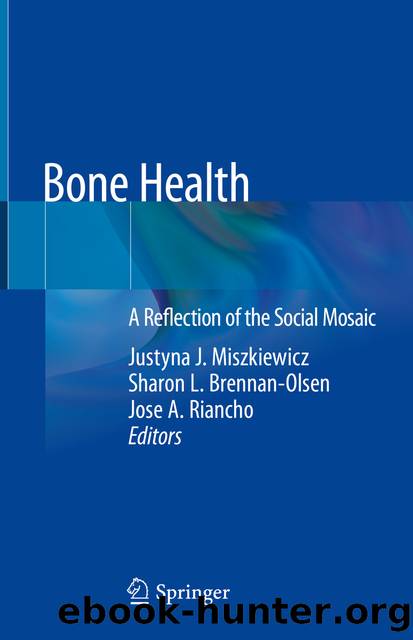Bone Health by Unknown

Author:Unknown
Language: eng
Format: epub
ISBN: 9789811372568
Publisher: Springer Singapore
6.3 Non-pharmacological Treatment
The first-line treatments for low BMD are non-pharmacological interventions, primarily vitamin D and/or calcium supplementation and physical activity.
Vitamin D is important for optimal calcium absorption and bone formation and assists in the regulation of calcium levels. The key source of vitamin D is ascertained from sunlight exposure of the skin: notably, exposure to ultraviolet B [UVB] light. Sun exposure should be outdoors, as UVB transmission is unlikely to occur through normal clear windows. Vitamin D deficiency may be more likely observed in older or housebound persons [including residents of aged-care facilities], individuals with naturally darker skin, those that avoid sun exposure such as persons whose bodies are covered for cultural or religious reasons, babies of mothers that are vitamin D deficient and those that are unable to absorb or process vitamin D [34].
Calcium plays an imperative role in normal growth and maintenance of bone and is a dynamic store of intra- and extracellular calcium pools [35]. Adequate dietary calcium intake is essential to achieve peak bone mass and to reduce age-related loss of bone [36]. Different life stages require different levels of dietary calcium intake, and recommendations for daily calcium intake vary between countries; however, the recommended daily consumption of calcium [from foods] can be achieved by consuming 3–5 serves daily of calcium-rich foods. In older community-based individuals and residents of aged-care facilities, reducing falls risk is imperative, with the end-goal being to reduce both falls and fractures. It is universally recommended that a combination of vitamin D and calcium supplementation be optimised in all residents of aged-care facilities [37]. However, previous research suggests that compared to other osteoporosis treatments, calcium and vitamin D supplementation have lower adherence rates among patients with osteoporosis [38]. Patients who discontinued calcium and vitamin D supplements were more likely to identify lack of motivation as the reason [38]. Fear of side effects was the most commonly cited reason for stopping other prescribed anti-fracture medications [38].
Age-specific requirements for the type, duration, intensity and regularity of physical activity have been proposed to maximise bone health [39]. The beneficial effect of selected exercise modalities on bone health ranges from those that are highly osteogenic [basketball/netball, impact aerobics, tennis, jumping], moderately osteogenic [running/jogging, hill walking, resistance training, stair climbing], low osteogenic [leisure walking, lawn bowls and yoga/Pilates], to non-osteogenic [swimming, cycling] [39]. Whilst leisure walking is not recommended as an adequate strategy for bone health, this activity nonetheless provides overall health and fitness benefits.
Greater health literacy and higher SES have been associated with an increased uptake of preventive health behaviours, including better diet quality [29, 40] and increased physical activity levels [24, 29, 40, 41]. It has previously been suggested health literacy may be important in meeting dietary calcium requirements [42]. However, there is a need for further research regarding the role of health literacy in preventive health behaviours directly related to bone health including dietary calcium intake, vitamin D levels and osteogenic activity.
Download
This site does not store any files on its server. We only index and link to content provided by other sites. Please contact the content providers to delete copyright contents if any and email us, we'll remove relevant links or contents immediately.
| Administration & Medicine Economics | Allied Health Professions |
| Basic Sciences | Dentistry |
| History | Medical Informatics |
| Medicine | Nursing |
| Pharmacology | Psychology |
| Research | Veterinary Medicine |
Periodization Training for Sports by Tudor Bompa(8175)
Why We Sleep: Unlocking the Power of Sleep and Dreams by Matthew Walker(6620)
Paper Towns by Green John(5094)
The Immortal Life of Henrietta Lacks by Rebecca Skloot(4529)
The Sports Rules Book by Human Kinetics(4304)
Dynamic Alignment Through Imagery by Eric Franklin(4125)
ACSM's Complete Guide to Fitness & Health by ACSM(3992)
Kaplan MCAT Organic Chemistry Review: Created for MCAT 2015 (Kaplan Test Prep) by Kaplan(3942)
Introduction to Kinesiology by Shirl J. Hoffman(3728)
Livewired by David Eagleman(3688)
The Death of the Heart by Elizabeth Bowen(3555)
The River of Consciousness by Oliver Sacks(3543)
Alchemy and Alchemists by C. J. S. Thompson(3453)
Bad Pharma by Ben Goldacre(3359)
Descartes' Error by Antonio Damasio(3232)
The Emperor of All Maladies: A Biography of Cancer by Siddhartha Mukherjee(3072)
The Gene: An Intimate History by Siddhartha Mukherjee(3050)
The Fate of Rome: Climate, Disease, and the End of an Empire (The Princeton History of the Ancient World) by Kyle Harper(3007)
Kaplan MCAT Behavioral Sciences Review: Created for MCAT 2015 (Kaplan Test Prep) by Kaplan(2941)
